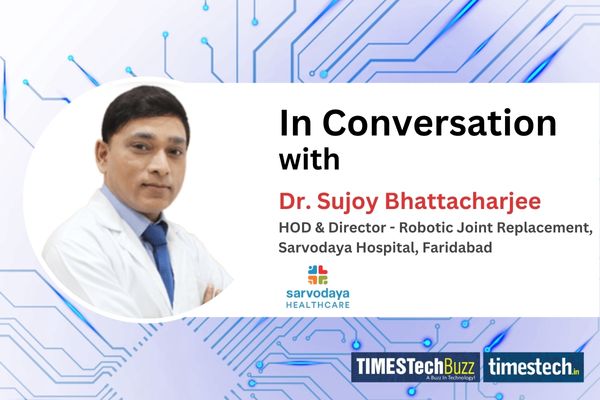In an interview with TimesTech, Dr. Sujoy Bhattacharjee of Sarvodaya Hospital explains how the CUVIS Joint Robot System revolutionizes joint replacement surgeries, enhancing precision, minimizing trauma, and speeding up patient recovery, setting new benchmarks in advanced orthopedic care.
Read the full interview here:
TimesTech: Can you elaborate on how Sarvodaya Hospital’s adoption of the CUVIS Joint Robot System has enhanced the precision and outcomes of joint replacement surgeries?
Sujoy: CUVIS Robotic system has completely transformed joint replacement surgeries. The robot makes precise bone cuts per dimension and protects the neighbouring healthy bones and tissues. The cruciate ligament (PCL) is completely preserved, and the implant position is highly accurate. There is minimal blood loss and bone loss. Additionally, the surgeries done without tourniquets using muscle-sparing, minimally invasive Subvastus approach are sutureless and stitchless. The patient gets the feeling of a natural knee without the feeling of an artificial implant. The surgeries are so smooth and safe that post-operative pain doesn’t remain an issue for the patient, and they recover very quickly. It allows the patient to walk on the same day of surgery and the patient can even take a shower the next day. The Robotic Joint Replacement Program at Sarvodaya has healed thousands of patients. We have brought another Joint Replacement Robot to cater to more people and give them freedom to walk. As opposed to traditional surgeries, robotic surgeries are single visit surgeries and patients don’t need to visit again for any follow-ups.
TimesTech: How does the CUVIS system’s use of 3D imaging for pre-surgical planning contribute to more precise cuts and optimal implant placement?
Sujoy: The CUVIS robotic joint replacement system utilizes advanced 3D imaging technology for pre-surgical planning, which significantly enhances the precision and accuracy of knee replacement procedures. Here’s how the 3D imaging contributes to more precise cuts and optimal implant placement:
1. Detailed anatomical mapping:
- The system creates a highly detailed 3D model of the patient’s knee joint using CT scans or MRI.
- This allows surgeons to visualize the unique anatomy of each patient’s joint in great detail before surgery.
2. Precise surgical planning:
- Surgeons can use the 3D model to plan the exact location and orientation of bone cuts.
- They can determine the optimal size and position of the implant components virtually before the actual procedure.
3. Customized approach:
- The 3D imaging enables a personalized surgical plan tailored to each patient’s specific anatomy and needs.
- This customization helps address individual variations in bone structure and joint alignment.
4. Improved accuracy:
- During surgery, the robotic arm uses the pre-planned 3D model as a guide.
- This ensures that bone cuts are made exactly as planned, with sub-millimeter accuracy.
5. Real-time feedback:
- The system provides real-time visual feedback to the surgeon during the procedure.
- This allows for immediate adjustments if needed, further enhancing precision.
6. Optimal implant positioning:
- The 3D planning helps surgeons determine the ideal placement of implant components.
- This can lead to better joint function, improved range of motion, and potentially longer implant life.
7. Soft tissue preservation:
- Precise planning and execution help minimize unnecessary bone removal and soft tissue damage.
- This can contribute to faster recovery and better overall outcomes.
8. Improved alignment:
- The 3D imaging and robotic assistance help achieve optimal mechanical alignment of the knee joint.
- This can reduce the risk of implant wear and improve long-term outcomes.
TimesTech: What specific advantages does robotic-assisted surgery offer in terms of minimizing trauma to bones and tissues compared to traditional methods?
Sujoy: Robotic-assisted surgery, like that performed with the CUVIS system, offers several specific advantages in minimizing trauma to bones and tissues compared to traditional surgical methods:
- Precise Bone Cuts
Robotic-assisted surgery allows for extremely accurate bone cuts as planned in a 3D model. This precision ensures that only the necessary amount of bone is removed, preserving healthy bone and minimizing trauma. The meticulous nature of robotic systems enhances surgical outcomes and reduces complications associated with excessive bone removal.
- Minimized Soft Tissue Damage
Carefully calibrated movements of the robotic arm avoid unnecessary contact with surrounding soft tissues. This precision helps reduce swelling, pain, and potentially speeds up recovery. By minimizing soft tissue damage, patients experience fewer postoperative complications and discomfort.
- Smaller Incisions
The precision offered by robotic systems often enables surgeons to make smaller incisions compared to traditional methods. Smaller incisions mean less tissue trauma, leading to faster healing and a quicker return to normal activities. This minimally invasive approach is a significant advantage for patients undergoing surgery.
- Elimination of Manual Error
Robotic systems eliminate the possibility of hand tremors or accidental slips that can occur in manual surgery. The steady and precise movement of robotic arms reduces the risk of unintended damage to surrounding structures, ensuring a safer surgical procedure.
- Optimal Implant Fit
Robotic-assisted surgery ensures precise bone preparation, which results in a better fit for implant components. This precision reduces stress on surrounding tissues and bones during healing and long-term use. An optimal implant fit is crucial for the longevity and success of the surgical outcome.
- Preservation of Ligament Balance
Robotic systems help achieve optimal ligament tension and balance, leading to better joint stability. This precise balancing reduces strain on soft tissues post-surgery, enhancing overall joint function and patient comfort.
- Reduced Blood Loss
The precision of robotic surgery often results in less bleeding during the procedure. Reduced blood loss can lead to faster recovery and a lower risk of complications. This advantage is particularly beneficial for patients with higher risks associated with blood loss.
- Customized Approach
Robotic-assisted surgery allows for a customized approach based on each patient’s unique anatomy. This personalization enables a more tissue-preserving method, minimizing unnecessary trauma to healthy structures. Tailoring the surgery to the individual needs of the patient enhances the overall effectiveness and satisfaction with the procedure.
TimesTech: Can you share some insights on the recovery process for patients who undergo robotic joint replacement surgery at Sarvodaya Hospital? How does the accuracy of implant placement impact recovery times and the longevity of the joint replacement?
Sujoy: At Sarvodaya’s Centre for Robotic Joint Replacement, we ensure comprehensive care of the patient from pre-to-post-operation. The patients are provided with complete rehabilitation facilities by experienced physiotherapists, who with the help of exercises and therapies help the patient take their first step, just a few hours after the surgery. The robotic surgeries are stapleless & sutureless surgeries that ensure swift recovery of the patient. Another reason for quick recovery could be the high precision of the surgery and reduced tissue trauma. The patient usually can get discharged on the same day of surgery and thus can resume basic routine activities sooner. The patient can walk on the same day of surgery without the feeling of having an artificial implant. Precise implant placement often results in less post-operative pain, potentially reducing the need for pain medications.
- Faster Recovery Times
Robotic-assisted surgery offers precise placement, reducing trauma to surrounding tissues. This precision leads to less pain and swelling, which allows for earlier mobility and faster overall recovery.
- Improved Joint Function
Accurate placement ensures optimal alignment and balance of the joint, resulting in better range of motion and more natural joint movement. This precision enhances the overall functionality of the joint, improving the patient’s ability to perform daily activities.
- Reduced Risk of Complications
Proper alignment achieved through robotic surgery minimizes abnormal wear on the implant and surrounding structures. This careful placement lowers the risk of post-operative complications such as instability or implant loosening, leading to more reliable surgical outcomes.
- Enhanced Longevity of the Implant
Precise placement during robotic-assisted surgery distributes forces evenly across the implant. This even distribution significantly extends the lifespan of the joint replacement, potentially reducing the need for revision surgeries in the future.
- Better Patient Satisfaction
Accurate placement often leads to improved joint function and reduced pain. As a result, patients typically report higher satisfaction levels and an enhanced quality of life post-surgery. The overall success of the procedure contributes to greater patient happiness.
TimesTech: How does Sarvodaya Hospital ensure a comprehensive care experience for patients undergoing robotic joint replacement surgery, from preoperative to postoperative stages?
Sujoy: The patient is provided comprehensive care from the first touch point when they visit the centre for the first time. The patient is provided with proper counselling about their condition, the treatment and the recovery process. The robotic surgeries are performed with utmost safety and accuracy as per internationally accepted protocols. Post-operation, the patient is provided with rehabilitation by physiotherapy experts who guide the patient with exercises and therapy, helping the patient to walk on the same day of surgery. The recovery is so fine that the patient can perform routine tasks within a few days. The surgery is a single-visit surgery, and the patients are not required to visit the hospital again for any follow-ups, however, if they have any queries, they can consult again from the doctors. The patients are also given the provision of diet counselling and ayurvedic panchkarma therapies that enhance the recovery process. The patients are guided well about the recovery process and precautions before discharge.
TimesTech: Being North India’s first hospital to use the fully active CUVIS Joint Robot System, what benchmarks or milestones has Sarvodaya Hospital achieved in the field of advanced orthopaedic care?
Sujoy: We have proudly performed over 3,500 robotic joint replacement surgeries, establishing ourselves as leaders in this advanced field. Our center is the world’s first to perform cruciate retaining robotic joint replacement surgery, setting a new standard in surgical innovation. Additionally, we are North India’s first center to introduce two robots for joint replacement, enabling us to serve a larger section of society more efficiently. Our robotic joint replacement program is designed for utmost convenience, allowing patients to undergo single-visit surgeries where they can walk on the same day, be discharged on the same day, and avoid the need for follow-up hospital visits.


















